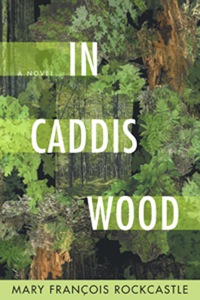 While reading In Caddis Wood (Graywolf), Mary François Rockcastle’s second novel, I was immediately struck by its resemblance to Wallace Stegner’s masterful Crossing to Safety. Both books examine long-term relationships and the problems of growing older. Both pay homage to the importance of place, in this case, a summer home in the woods of Wisconsin, in securing the characters, and both display a solemn, awed regard for the natural world. Like Stegner, Rockcastle deftly describes this circumscribed world. Her regard for the beauties and ambiguities of nature breathe life into Caddis Wood.
While reading In Caddis Wood (Graywolf), Mary François Rockcastle’s second novel, I was immediately struck by its resemblance to Wallace Stegner’s masterful Crossing to Safety. Both books examine long-term relationships and the problems of growing older. Both pay homage to the importance of place, in this case, a summer home in the woods of Wisconsin, in securing the characters, and both display a solemn, awed regard for the natural world. Like Stegner, Rockcastle deftly describes this circumscribed world. Her regard for the beauties and ambiguities of nature breathe life into Caddis Wood.
A domestic drama of the first rate, In Caddis Wood is the story of Hallie and Carl Fens and how they face Carl’s terminal illness. The reader gets an intimate view on the Fens’s marriage, family and the attendant entanglements of romance, professional ambition, the inevitable stresses and strains of life. The Fens and their twin girls struggle to understand one another. The daughters grapple with Carl’s workaholic nature, which often diverted attention from them. Through such understanding, these family members learn to forgive one another for the hurts inflicted over the years, intentional or not.
In Caddis Wood unfolds in third-person with chapters alternating between the perspective of husband and wife. This choice allows the reader to know each character more intimately, richly describing their marriage. And, since one of the characters is unwell, this call and response steadies the boat of the narrative.
Though the themes – age, disease, death – are heavy, Rockcastle’s prose, while not as precise and succinct as Stegner’s, still carries a lyrical quality.
It is midafternoon and the snow is still falling–thick, papery flakes that paint the air with dots. The ground has been rising steadily; the new snow swallows the paths Carl shoveled only this morning. Slowly, he peels an orange, arranges the cool, fragrant pieces in a meandering line along the window ledge. It is an old habit. Not that he does it on purpose to annoy Hallie. He simply loves the sensuality of the fruit, its smell and taste and texture, the act of placing the peel in that particular place beside the glass.
Here, Rockcastle layers the past upon the present with the sure guide of Carl’s habit. Not only does the reader gain intimacy with these characters, they are profoundly known by each other.
In tone, both books convey the poignancy of aging, the slow disintegration of the body that ends in death. Nostalgia and sentimentality, familiar to any writer who takes up mortality as a subject, enrich the book. These emotions, often maligned, comprise human experience, and if genuinely rendered can be quite moving.
One minor quibble: at the outset, supporting characters are introduced quickly and keeping those characters and relationships straight took work. These characters are important: this book is about more than husband and wife; but the way a marriage becomes enmeshed in kin and kindred. But that hardly detracts from this sensitive, clear-eyed portrayal of a union that has lasted more than thirty years – the joys, healed-over wounds, and love that endure in spite, perhaps because, of the ambitions and secrets that have threatened along the way.
Extras
- On maryfrancoisrockastle.com find the usual goods + background on the Pushcart Prize-winning literary journal, the Water~Stone Review, which Rockastle founded at Hamline University in 1997.
- Speaking of place and the brevity of human life, Wallace Stegner’s “Wilderness Letter,” written to the Outdoor Recreation Resources Review Commission of California in 1960, remains a testament to a writer’s passion for wildness – keeping our enjoyment of it out of the equation.







